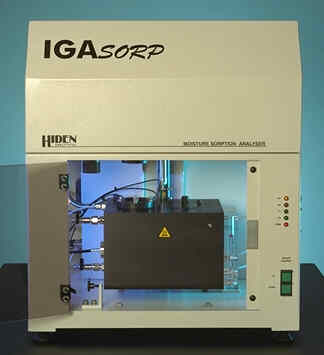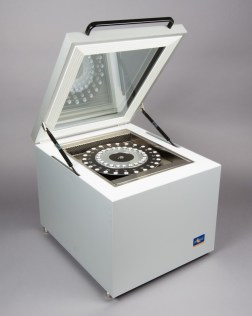The Dynamic Vapor Sorption (DVS) technique
Dynamic Vapour Sorption or DVS analysis is a widely used gravimetric technique for the measurement of vapour interactions with solids.
In many cases, the vapour of interest is water, because of the presence of moisture during manufacturing, storage and use of materials, from foods and drugs to plastics, paper, chemicals, and geological samples.
The measurement of water vapor sorption isotherms is now a fundamental characterisation technique in many of these fields.
The DVS instrument
The DVS measurement technique involves:
- A sample held in a temperature controlled chamber.
- A stream of carrier gas with controlled vapour content. Usually this is generated by controlled mixing of a pure (dry) carrier flow with a vapour-saturated flow.
- A sensitive microbalance, to measure the absorption and desorption of the vapour.
All modern DVS instruments are software controlled, and allow programming of the measurements without user intervention. Additional features of a DVS instrument may include:
- Independent thermostatting of the microbalance
- Purge or flushing of the microbalance, to avoid condensation or contamination
- Sample heaters for enhanced drying
- Vapour pressure or humidity sensors
- Programmable gas flow rates
- Software control allowing ramp and steady state control of temperature and vapour composition
DVS measurement strategies
DVS measurements are typically performed at constant pressure and with a constant total flow rate, to minimise the buoyancy and flow force effects.
The measurements are normally performed at a fixed temperature, to obtain moisture sorption isotherm curves, by allowing the sample to equilibrate at a series of different vapour concentrations.
The measurement is often very sensitive to temperature, requiring very stable temperature control. Repeated measurements at several different temperatures are commonly used to probe the thermodynamics of the sorption process.
The dynamic method is particularly useful where the sample may release vapours or gases when it interacts with the analysis vapour. This is very often the case with foods, which often release moisture or volatile organic compounds, and also for many organic pharmaceutical compounds, which can release solvents trapped during synthesis. In some cases, the sample can lose up to half its weight due to this effect. The continuous flow of gas eliminates these contaminant vapours, which can lead to false results if allowed to accumulate, as in a static measurement method, where there is no flow of gas.
Gravimetric Vapour Sorption instruments of this type, such as the Hiden Isochema IGAsorp or the multisample SPS and Vsorp instruments from ProUmid GmbH are very cost-effective and allow rapid measurement of moisture sorption isotherms.
Depending on the application, the sample size may vary from a few milligrams, as for a novel pharmaceutical material, to tens or hundreds of grams for building materials or foodstuffs.
Our offer
We propose a range of instruments for Dynamic Vapour Sorption measurements:
- the benchtop IGAsorp for sorption of water and other vapours
- Multisample DVS instruments from ProUmid GmbH, allowing simultaneous moisture sorption measurement of up to 23 samples
- Additionally, several versions of the Hiden Isochema IGA series allow dynamic vapour sorption measurements, with special adaptations which include vacuum pretreatments, multiple vapour measurements, high and low temperature capabilities, etc.
More Information
For more details of any of these instruments, or if you would like to discuss your application, please contact us.

